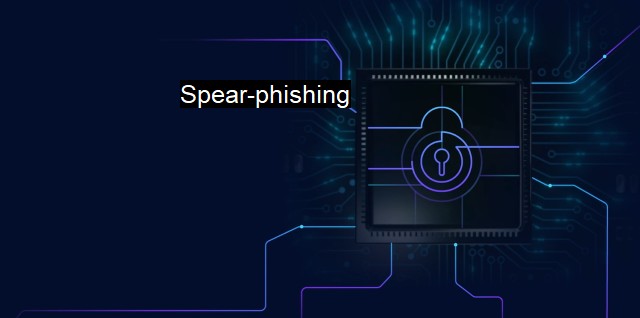What is Spear-phishing?
Spear-Phishing: A Deceptive and Devastating Cyber-Attack Targeting Personal Information and Computer Systems
Spear-phishing is a specialized form of phishing that targets particular individuals or organizations with the purpose of extracting valuable information or manipulating the target to perform specific tasks that could lead to severe losses. It is often directed at decision-makers in entitles who are in active control of crucial information or resources. The strategy and execution of spear-phishing attacks are meticulous and more intricate than conventional phishing attacks, contributing to their typical effectiveness.In the sphere of cybersecurity, phishing is correctly recognized as one of the most prevalent and potent cyber threats. its subset, spear-phishing, stakes an even graver peril. A considerable part of spear-phishing's volatility is due to its detailed approach. Malefactors operating spear-phishing scams often invest a significant amount of time and resources in researching their victims. Facts such as specific professional roles, data linked to those roles, and relevant social media interactions are systematically logged and utilized.
Instead of casting a large net with generic bait, spear-phishing aggressively narrows its intention, often to a sole individual. Predators artfully adapt messages to echo common, noncontroversial, or even routine everyday communication patterns typical to the prey, further enhancing the disguise. This method often exploits the target's trust in the sender's identity, i.e., the fraudulent email will appear to be from a trusted coworker or a reliable partner company's representative.
a typical spear-phishing occurrence might entail the malefactor composing an email mimicking the CEO of the targeted firm. The email might call for a fiscal officer to remit funds urgently for a business deal, with the predator's account presented as the benign receiver. Unfortunately, once the payment gets transmitted, retrieving it is next to impossible.
Unveiling the execution of a spear-phishing attack can be perplexing. Commonly, spear-phishing is orchestrated through email, although attackers are swiftly grasping the essence of exploiting instant messages and short message service (SMS). Employing URLs that look alike trusted websites is general practice too. These URLs can deliver attacker-controlled malware to user devices or direct victims to an attacker-controlled website.
Fortunately, spear-phishing defense strategies decisively articulate as part of cybersecurity and antivirus platforms. Users are advised to scrutinize and verify the origin of dubious messages that focus on obtaining specifics or executing tasks substantially. A thoroughly updated antivirus software could become indispensable against potential spear-phishing undertakings. These state-of-the-art software have improved detection systems to identify and report any suspicious links or emails.
Employing robust-spam filters that flag keywords commonly found in phishing email subjects can obstruct unwarranted communication. Executing an encrypted channel of communication between servers further elevates the safety measure intensifying the suppression against spear-phishing. The encryption makes it incredibly hard for the attacker to pose as a legitimate email sender.
All-inclusive employee training, therefore, is crucial as it reduces the opportunities perpetrators search. Cultivating a cybersecurity-heavy organizational culture requires vigilance and rapid response to threats. Leaders and employees must learn and continually update their knowledge of spear-phishing tactics and key identifiers of an attack to stay one step ahead.
While technology has remarkably streamlined our lives, it has also opened floodgates to sophisticated cybercrimes like spear-phishing. Security gaps may result from overtrust, lack of awareness, negligence, or inadequate system defenses, which spear-phishing looks to exploit. Implementing advanced cybersecurity and employing efficient antivirus applications remains an effective defense against these cyber predators. It necessitates understanding the attack complexity for users, creating a safety culture at work, and investing in a robust cybersecurity tech stack.

Spear-phishing FAQs
What is spear-phishing?
Spear-phishing is a targeted type of cyber attack where an attacker poses as a trusted source and sends messages, often via email, to specific individuals or groups to trick them into revealing sensitive information or taking some other malicious action.How does spear-phishing differ from regular phishing?
Spear-phishing attacks are more targeted and personalized than regular phishing attacks. Spear-phishing messages are tailored to the specific recipient's interests or position, making them more convincing and difficult to detect.What are some common signs of a spear-phishing attack?
Some common signs of a spear-phishing attack include receiving unsolicited emails that appear to be from a trusted source, requests for sensitive information, and links or attachments that seem suspicious or out of place.How can I protect myself from spear-phishing attacks?
To protect yourself from spear-phishing attacks, you should always be wary of unsolicited emails, especially those that ask for sensitive information or contain suspicious links or attachments. It's also a good idea to use antivirus software and to keep your software and operating system up to date with the latest security patches. Finally, education and awareness are key. Make sure you and your employees are trained to recognize and report suspicious messages.Related Topics
Phishing Attacks Email Security Malware Protection Cybersecurity Awareness Two-Factor Authentication
| | A | | | B | | | C | | | D | | | E | | | F | | | G | | | H | | | I | | | J | | | K | | | L | | | M | |
| | N | | | O | | | P | | | Q | | | R | | | S | | | T | | | U | | | V | | | W | | | X | | | Y | | | Z | |
| | 1 | | | 2 | | | 3 | | | 4 | | | 7 | | | 8 | | |||||||